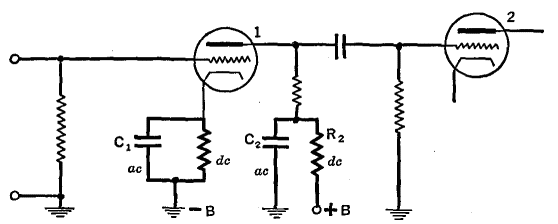| Basic Radio is a free introductory textbook on electronics based on tubes. See the editorial for more information.... |

|

Home  Basic Circuits Basic Circuits  Some Simple Amplifiers Some Simple Amplifiers  Filtering for the Voltage Supplies Filtering for the Voltage Supplies |
||||||






|
||||||
|
Filtering for the Voltage SuppliesAuthor: J.B. Hoag
Figure 13 K shows how partially to overcome these difficulties by the use of suitably located bypass condensers: C1 across the C-bias resistor, and C2 across the plate battery. It would be uneconomical to use separate B-batteries or plate-voltage supply systems for each tube in a multistage amplifier; nor is it necessary except in certain special cases.
Figure 13 L shows a filtered circuit wherein the same B-voltage is used with two transformer-coupled stages. It will be noticed in Figs. 13 K and 13 L, that additional high resistances R2 and R3 (called " de-coupling resistors ") are used in series with the supply line. These assist the bypass condensers to keep the a.c. out of the d.c. supply circuits and also to drop the B-voltage to the correct value for each tube.
|
||||||
Home  Basic Circuits Basic Circuits  Some Simple Amplifiers Some Simple Amplifiers  Filtering for the Voltage Supplies Filtering for the Voltage Supplies |
||||||
Last Update: 2009-11-01



